SLLSET1B January 2016 – February 2017 SN75LVPE802
PRODUCTION DATA.
- 1 Features
- 2 Applications
- 3 Description
- 4 Revision History
- 5 Description (continued)
- 6 Pin Configuration and Functions
- 7 Specifications
- 8 Detailed Description
- 9 Application and Implementation
- 10Power Supply Recommendations
- 11Layout
- 12Device and Documentation Support
- 13Mechanical, Packaging, and Orderable Information
パッケージ・オプション
デバイスごとのパッケージ図は、PDF版データシートをご参照ください。
メカニカル・データ(パッケージ|ピン)
- RTJ|20
サーマルパッド・メカニカル・データ
- RTJ|20
発注情報
7 Specifications
7.1 Absolute Maximum Ratings
over operating free-air temperature range (unless otherwise noted)(1)| MIN | MAX | UNIT | ||
|---|---|---|---|---|
| Supply Voltage Range(2), VCC | –0.5 | 4 | V | |
| Voltage Range | Differential I/O | –0.5 | 4 | V |
| Control I/O | –0.5 | VCC + 0.5 | V | |
| Continuous power dissipation | See Thermal Information | |||
| Storage temperature, Tstg | 150 | °C | ||
(1) Stresses beyond those listed under Absolute Maximum Ratings may cause permanent damage to the device. These are stress ratings only, which do not imply functional operation of the device at these or any other conditions beyond those indicated under Recommended Operating Conditions. Exposure to absolute-maximum-rated conditions for extended periods may affect device reliability.
(2) All voltage values, except differential voltages, are with respect to network ground terminal.
7.2 ESD Ratings
| VALUE | UNIT | |||
|---|---|---|---|---|
| V(ESD) | Electrostatic discharge | Human-body model (HBM), per ANSI/ESDA/JEDEC JS-001(1) | ±10000 | V |
| Charged-device model (CDM), per JEDEC specification JESD22-C101(2) | ±1500 | |||
| Machine model(3) | ±200 | |||
(1) JEDEC document JEP155 states that 500-V HBM allows safe manufacturing with a standard ESD control process.
(2) JEDEC document JEP157 states that 250-V CDM allows safe manufacturing with a standard ESD control process.
(3) Tested in accordance with JEDEC Standard 22, Test Method A115-A
7.3 Recommended Operating Conditions
over operating free-air temperature range (unless otherwise noted)| MIN | NOM | MAX | UNIT | ||
|---|---|---|---|---|---|
| VCC | Supply Voltage | 3 | 3.3 | 3.6 | V |
| C(coupling) | Coupling Capacitor | 12 | nF | ||
| TA | Operating free-air temperature | 0 | 85 | °C | |
7.4 Thermal Information
| THERMAL METRIC(1) | SN75LVPE802 | UNIT | |
|---|---|---|---|
| RTJ (WQFN) | |||
| 20 PINS | |||
| RθJA | Junction-to-ambient thermal resistance | 38 | °C/W |
| RθJC(top) | Junction-to-case (top) thermal resistance | 40 | °C/W |
| RθJB | Junction-to-board thermal resistance | 10 | °C/W |
| ψJT | Junction-to-top characterization parameter | 0.5 | °C/W |
| ψJB | Junction-to-board characterization parameter | 0.9 | °C/W |
| RθJC(bot) | Junction-to-case (bottom) thermal resistance | 15.2 | °C/W |
(1) For more information about traditional and new thermal metrics, see the Semiconductor and IC Package Thermal Metrics application report.
7.5 Electrical Characteristics
over operating free-air temperature range (unless otherwise noted)| PARAMETER | TEST CONDITIONS | MIN | TYP | MAX | UNIT | |
|---|---|---|---|---|---|---|
| PD | Power dissipation in active mode | DEWX = EN = VCC, EQX = DEX = NC, K28.5 pattern at 6 Gbps, VID = 700 mVpp | 188 | 205 | mW | |
| PSD | Power dissipation in standby mode | EN = 0 V, DEWX = EQX = DEX = NC, K28.5 pattern at 6 Gbps, VID = 700 mVpp | 4 | mW | ||
| ICC | Active mode supply current | EN = 3.3 V, DEWX = EQX = DEX = NC, K28.5 pattern at 6 Gbps, VID = 700 mVpp | 57 | 62 | mA | |
| ICC(STDBY) | Standby mode supply current | EN = 0 V | 1 | mA | ||
| Maximum data rate | 8 | Gbps | ||||
| OOB | ||||||
| V(OOB) | Input OOB threshold | F = 750 MHz | 50 | 78 | 150 | mVpp |
| DVdiff(OOB) | OOB differential delta | 25 | mV | |||
| DVCM(OOB) | OOB common-mode delta | 50 | mV | |||
| CONTROL LOGIC | ||||||
| VIH | High-level input voltage | For all control pins | 1.4 | V | ||
| VIL | Low-level input voltage | 0.5 | V | |||
| VIN(HYS) | Input hysteresis | 115 | mV | |||
| IIH | High-level input current | EQx, DEx = VCC | 30 | µA | ||
| EN, DEWx = VCC | 1 | µA | ||||
| IIL | Low-level input current | EQx, DEx = GND | –30 | µA | ||
| EN, DEWx = GND | –10 | µA | ||||
| RECEIVER AC/DC | ||||||
| Z(DIFFRX) | Differential-Input Impedance | 85 | 100 | 115 | Ω | |
| Z(SERX) | Single-Ended Input Impedance | 40 | Ω | |||
| VCM(RX) | Common-mode voltage | 1.8 | V | |||
| RL(DiffRX) | Differential mode return Loss (RL) | f = 150 MHz – 300 MHz | 22 | 28 | dB | |
| f = 300 MHz – 600 MHz | 14 | 17 | dB | |||
| f = 600 MHz – 1.2 GHz | 10 | 12 | dB | |||
| f = 1.2 GHz – 2.4 GHz | 8 | 9 | dB | |||
| f = 2.4 GHz – 3 GHz | 7 | 9 | dB | |||
| f = 3 GHz – 5 GHz | 6 | 8 | dB | |||
| RX(DiffRLSlope) | Differential mode RL slope | f = 300 MHz – 6 GHz | 14 | dB/dec | ||
| RL(CMRX) | Common mode return loss | f = 150 MHz – 300 MHz | 9 | 10 | dB | |
| f = 300 MHz – 600 MHz | 14 | 17 | dB | |||
| f = 600 MHz – 1.2 GHz | 15 | 23 | dB | |||
| f = 1.2 GHz – 2.4 GHz | 13 | 16 | dB | |||
| f = 2.4 GHz – 3 GHz | 10 | 12 | dB | |||
| f = 3 GHz – 5 GHz | 4 | 6 | dB | |||
| V(diffRX) | Differential input voltage PP | f = 1.5 GHz and 3 GHz | 120 | 1600 | mVppd | |
| IB(RX) | Impedance Balance | f = 150 MHz – 300 MHz | 30 | 41 | dB | |
| f = 300 MHz – 600 MHz | 30 | 38 | dB | |||
| f = 600 MHz – 1.2 GHz | 20 | 32 | dB | |||
| f = 1.2 GHz – 2.4 GHz | 10 | 26 | dB | |||
| f = 2.4 GHz – 3 GHz | 10 | 25 | dB | |||
| f = 3 GHz – 5 GHz | 4 | 20 | dB | |||
| f = 5 GHz – 6.5 GHz | 4 | 17 | dB | |||
| TRANSMITTER AC/DC | ||||||
| Z(diffTX) | Pair differential impedance | 85 | 100 | 122 | Ω | |
| Z(SETX) | Single-Ended input Impedance | 40 | Ω | |||
| V(TXtrans) | Sequencing transient voltage | Transient voltages on the serial data bus during power sequencing (lab load) | –1.2 | 1.2 | V | |
| RL(DiffTX) | Diff Mode return Loss | f = 150 MHz – 300 MHz | 19 | 25 | dB | |
| f = 300 MHz – 600 MHz | 17 | 19 | dB | |||
| f = 600 MHz – 1.2 GHz | 11 | 14 | dB | |||
| f = 1.2 GHz – 2.4 GHz | 8 | 10 | dB | |||
| f = 2.4 GHz – 3 GHz | 8 | 10 | dB | |||
| f = 3 GHz – 5 GHz | 8 | 10 | dB | |||
| TX(DiffRLSlope) | Differential-mode RL slope | f = 300 MHz to 3 GHz | 14 | dB/dec | ||
| RL(CMTX) | Common Mode return Loss | f = 150 MHz – 300 MHz | 16 | 20 | dB | |
| f = 300 MHz – 600 MHz | 15 | 19 | dB | |||
| f = 600 MHz – 1.2 GHz | 14 | 17 | dB | |||
| f = 1.2 GHz – 2.4 GHz | 10 | 12 | dB | |||
| f = 2.4 GHz – 3 GHz | 9 | 11 | dB | |||
| f = 3 GHz – 5 GHz | 6 | 7 | dB | |||
| I(BTX) | Impedance Balance | f = 150 MHz – 300 MHz | 30 | 41 | dB | |
| f = 300 MHz – 600 MHz | 30 | 38 | dB | |||
| f = 600 MHz – 1.2 GHz | 20 | 33 | dB | |||
| f = 1.2 GHz – 2.4 GHz | 10 | 24 | dB | |||
| f = 2.4 MHz – 3 GHz | 10 | 26 | dB | |||
| f = 3 GHz – 5 GHz | 4 | 22 | dB | |||
| f = 5 GHz – 6.5 GHz | 4 | 21 | dB | |||
| DE | Output de-emphasis (relative to transition bit) |
DE1 0r DE2 = 0 | 0 | dB | ||
| DE1 0r DE2 = 1 | –2 | dB | ||||
| DE1 0r DE2 = NC | –4 | dB | ||||
| Diff(VppTX_DE) | Differential output-voltage swing dc level | DE1 0r DE2 = 0 | 550 | mV | ||
| DE1 0r DE2 = 1 | 830 | mV | ||||
| DE1 0r DE2 = NC | 630 | mV | ||||
| V(CMAC_TX) | TX AC CM Voltage | At 1.5 GHz | 20 | 50 | mVppd | |
| At 3 GHz | 12 | 26 | dBmV (rms) | |||
| At 6 GHz | 13 | 30 | dBmV (rms) | |||
| V(CMTX) | Common-Mode Voltage | 1.8 | V | |||
| TX(R/FImb) | TX rise-fall imbalance | At 3 GHz | 6% | 20% | V | |
| TX(AmpImb) | TX amplitude imbalance | 2% | 10% | V | ||
7.6 Timing Requirements
| MIN | NOM | MAX | UNIT | ||||
|---|---|---|---|---|---|---|---|
| DEVICE PARAMETERS | |||||||
| Auto low-power entry time | Electrical idle at input (see Figure 24) | 80 | 105 | 130 | ps | ||
| Auto low-power exit time | After first signal activity (see Figure 24) | 42 | 50 | ps | |||
| TRANSMITTER AC/DC | |||||||
| tDE | Input OOB threshold | DEW1 or DEW2 = 0 | 94 | ps | |||
| DEW1 or DEW2 = 1 | 215 | ps | |||||
| OUT-OF-BAND (OOB) | |||||||
| tOOB1 | OOB mode enter | See Figure 23 | 3 | 5 | ns | ||
| tOOB2 | OOB mode exit | 3 | 5 | ns | |||
7.7 Switching Characteristics
over operating free-air temperature range (unless otherwise noted)| PARAMETER | TEST CONDITIONS | MIN | TYP | MAX | UNIT | |
|---|---|---|---|---|---|---|
| DEVICE PARAMETERS | ||||||
| tPDelay | Propagation delay | Measured using K28.5 pattern (see Figure 1) |
323 | 400 | ps | |
| tENB | Device enable time | EN 0 → 1 | 5 | µs | ||
| tDIS | Device disable time | EN 1 → 0 | 2 | µs | ||
| RECEIVER AC/DC | ||||||
| t20-80RX | Rise/fall time | Rise times and fall times measured between 20% and 80% of the signal. SATA 6-Gbps speed measured 1 in, (2.5 cm) from device pin. | 62 | 75 | ps | |
| tSKEWRX | Differential skew | Difference between the single-ended midpoint of the RX+ signal rising or falling edge, and the single-ended midpoint of the RX– signal falling or rising edge. | 30 | ps | ||
| TRANSMITTER AC/DC | ||||||
| t20-80TX | Rise/fall time | Rise times and fall times measured between 20% and 80% of the signal. At 6 Gbps under no load conditions. | 42 | 55 | 75 | ps |
| tSKEWTX | Differential skew | Difference between the single-ended midpoint of the TX+ signal rising or falling edge, and the single-ended midpoint of the TX– signal falling or rising edge. | 6 | 20 | ps | |
| TRANSMITTER JITTER | ||||||
| DJTX | Deterministic jitter (1) at CP in | VID = 500 mVpp, UI = 333 ps, K28.5 control character | 0.06 | 5 | UIp-p | |
| RJTX | Residual Random jitter(1) | VID = 500 mVpp, UI = 333 ps, K28.7 control character | 0.01 | 5 | ps-rms | |
| DJTX | Deterministic jitter (1) at CP in | VID = 500 mVpp, UI = 167 ps, K28.5 control character | 0.08 | 0.16 | UIp-p | |
| RJTX | Residual random jitter (1) | VID = 500 mVpp, UI = 167 ps, K28.7 control character | 0.09 | 2 | ps-rms | |
| DJTX | Deterministic jitter (1) at CP in | VID = 500 mVpp, UI = 125 ps, K28.5 control character | 0.1 | 0.2 | UIp-p | |
| RJTX | Residual random jitter(1) | VID = 500 mVpp, UI = 125 ps, K28.7 control character | 0.3 | 1.5 | ps-rms | |
(1) (1) TJ = (14.1 x RJSD + DJ), where RJSD is one standard deviation value
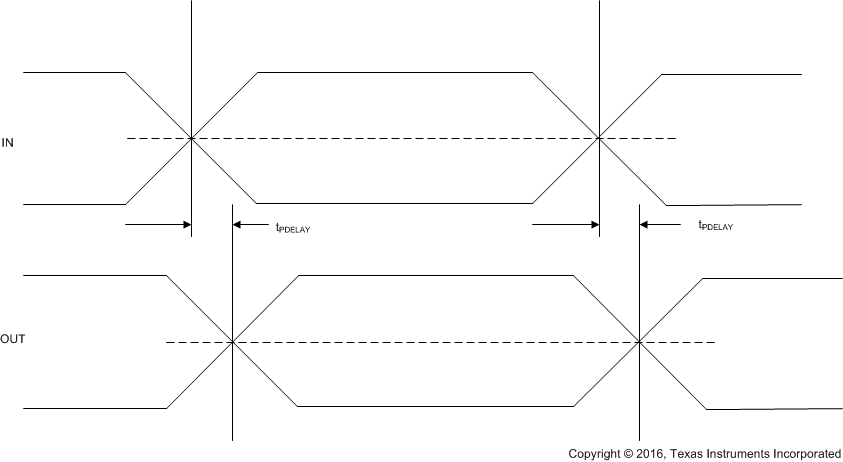 Figure 1. Propagation Delay Timing Diagram
Figure 1. Propagation Delay Timing Diagram
7.8 Typical Characteristics
Input signal characteristics:
- Data rate = 8 Gbps 6 bps, 3 Gbps, 1.5 Gbps
- Amplitude = 500 mVpp
- o Data pattern = K28.5
SN75LVPE802 device setup:
- Temperature = 25°C
- Voltage = 3.3 V
- De-emphasis duration = 117 ps (short)
- Equalization and de-emphasis set to optimize performance at 6 Gbps
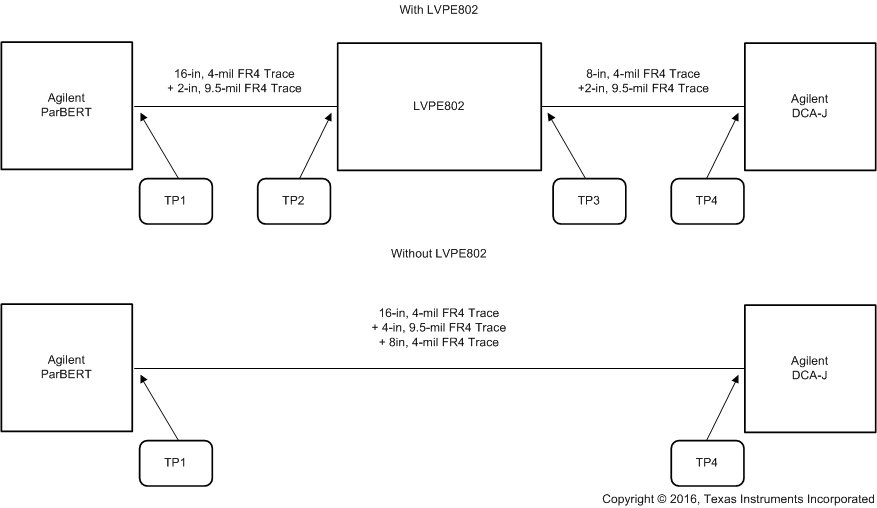 Figure 2. Performance Curve Measurement Setup
Figure 2. Performance Curve Measurement Setup
 Figure 3. Jitter Measurement Test Condition
Figure 3. Jitter Measurement Test Condition
7.8.1 Jitter and VOD results: Case 1 at 6 Gbps
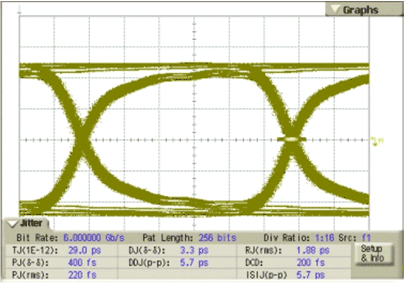
| TJ | DJ | RJ | Eye | Eye | Eye |
| (1e-12) ps | (σ-σ) ps | (rms) ps | Amplitude mV | Width ps | Opening (mV) |
| 29 | 3.3 | 1.88 | 412.4 | 159.2 | 350.52 |
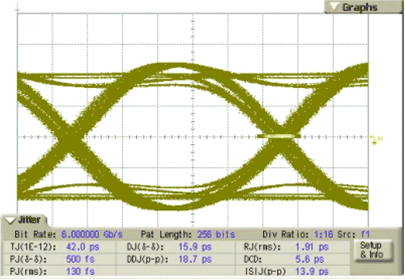
| TJ | DJ | RJ | Eye | Eye | Eye |
| (1e-12) ps | (σ-σ) ps | (rms) ps | Amplitude mV | Width ps | Opening (mV) |
| 42 | 15.9 | 1.91 | 788.8 | 141.3 | 623.02 |

| TJ | DJ | RJ | Eye | Eye | Eye |
| (1e-12) ps | (σ-σ) ps | (rms) ps | Amplitude mV | Width ps | Opening (mV) |
| 56.7 | 29.8 | 2 | 165.4 | 101 | 13.24 |
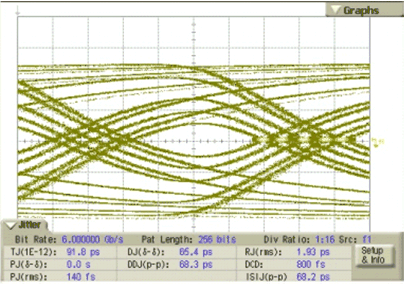
| TJ | DJ | RJ | Eye | Eye | Eye |
| (1e-12) ps | (σ-σ) ps | (rms) ps | Amplitude mV | Width ps | Opening (mV) |
| 91.8 | 65.4 | 1.93 | 240 | 28.9 | 81.24 |

| TJ | DJ | RJ | Eye | Eye | Eye |
| (1e-12) ps | (σ-σ) ps | (rms) ps | Amplitude mV | Width ps | Opening (mV) |
| 39 | 12.7 | 1.92 | 557.1 | 149.7 | 459.62 |
7.8.2 Jitter and VOD Results: Case 2 at 3 Gbps

| TJ | DJ | RJ | Eye | Eye | Eye |
| (1e-12) ps | (σ-σ) ps | (rms) ps | Amplitude mV | Width ps | Opening (mV) |
| 29.7 | 3.8 | 1.89 | 430.9 | 326 | 392.84 |

| TJ | DJ | RJ | Eye | Eye | Eye |
| (1e-12) ps | (σ-σ) ps | (rms) ps | Amplitude mV | Width ps | Opening (mV) |
| 39.6 | 12.8 | 1.96 | 714.5 | 321 | 611.62 |

| TJ | DJ | RJ | Eye | Eye | Eye |
| (1e-12) ps | (σ-σ) ps | (rms) ps | Amplitude mV | Width ps | Opening (mV |
| 128.6 | 101.8 | 1.96 | 258.8 | 118 | 122.26 |
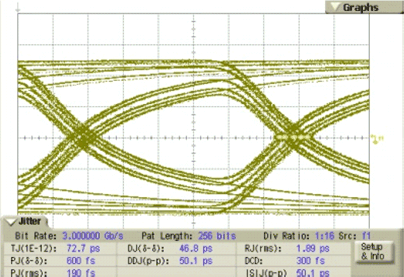
| TJ | DJ | RJ | Eye | Eye | Eye |
| (1e-12) ps | (σ-σ) ps | (rms) ps | Amplitude mV | Width ps | Opening (mV) |
| 72.7 | 46.8 | 1.89 | 314.9 | 237 | 222.36 |
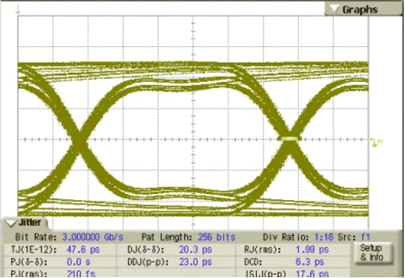
| TJ | DJ | RJ | Eye | Eye | Eye |
| (1e-12) ps | (σ-σ) ps | (rms) ps | Amplitude mV | Width ps | Opening (mV) |
| 47.9 | 20.3 | 1.99 | 615.3 | 305.0 | 463.42 |
7.8.3 Jitter and VOD Results: Case 3 at 1.5 Gbps

| TJ | DJ | RJ | Eye | Eye | Eye |
| (1e-12) ps | (σ-σ) ps | (rms) ps | Amplitude mV | Width ps | Opening (mV) |
| 34.3 | 3.4 | 2.26 | 448 | 659 | 417.28 |

| TJ | DJ | RJ | Eye | Eye | Eye |
| (1e-12) ps | (σ-σ) ps | (rms) ps | Amplitude mV | Width ps | Opening (mV) |
| 44.9 | 13.2 | 2.31 | 753.1 | 649 | 604.02 |

| TJ | DJ | RJ | Eye | Eye | Eye |
| (1e-12) ps | (σ-σ) ps | (rms) ps | Amplitude mV | Width ps | Opening (mV) |
| 113.3 | 81.9 | 2.3 | 322.8 | 493 | 217.48 |

| TJ | DJ | RJ | Eye | Eye | Eye |
| (1e-12) ps | (σ-σ) ps | (rms) ps | Amplitude mV | Width ps | Opening (mV) |
| 67.5 | 38.6 | 2.11 | 363.4 | 595 | 318.48 |
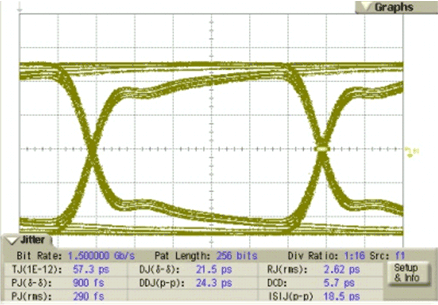
| TJ | DJ | RJ | Eye | Eye | Eye |
| (1e-12) ps | (σ-σ) ps | (rms) ps | Amplitude mV | Width ps | Opening (mV) |
| 57.3 | 21.5 | 2.62 | 672.8 | 632 | 442.42 |
7.8.4 Jitter and VOD Results: Case 4 at 8 Gbps
Figure 21 Test Point 3 and Figure 22 Test Point 4 were taken without pre-emphasis.

| TJ | DJ | RJ | Eye | Eye | Eye |
| (1e-12) ps | (σ-σ) ps | (rms) ps | Amplitude mV | Width ps | Opening (mV) |
| 14.4 | 10.1 | 0.31 | 580 | 108 | 274 |
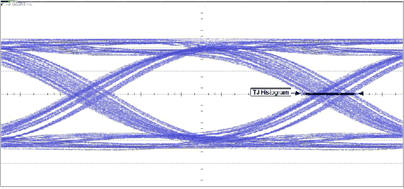
| TJ | DJ | RJ | Eye | Eye | Eye |
| (1e-12) ps | (σ-σ) ps | (rms) ps | Amplitude mV | Width ps | Opening (mV) |
| 30.6 | 23.6 | 0.51 | 406 | 86 | 292 |
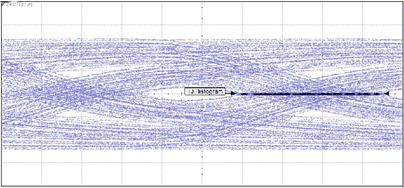
| TJ | DJ | RJ | Eye | Eye | Eye |
| (1e-12) ps | (σ-σ) ps | (rms) ps | Amplitude mV | Width ps | Opening (mV) |
| 78.1 | 68.9 | 0.67 | 310 | 45 | 48 |

| TJ | DJ | RJ | Eye | Eye | Eye |
| (1e-12) ps | (σ-σ) ps | (rms) ps | Amplitude mV | Width ps | Opening (mV) |
| 34.4 | 26.8 | 0.56 | 262 | 85 | 95 |